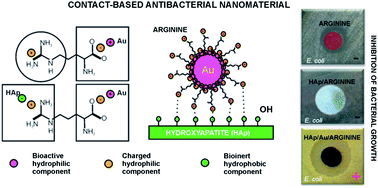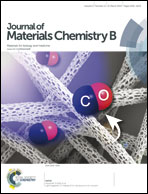Hydroxyapatite/gold/arginine: designing the structure to create antibacterial activity†
Abstract
Antimicrobial peptides, selective antimicrobials able to “recognize” and “target” bacterial cells, are significant advancement in comparison to non-selective antimicrobials widely used in practice. The major problem of this class of macromolecules is, however, a short half-life. Starting from the key physicochemical properties of antibacterial peptides, our intention was to develop their stable analogue. We designed hydroxyapatite/gold/arginine (HAp/Au/arginine) nanocomposite that contains: (i) hydrophobic gold (Au) nanoparticles, (b) positively charged, hydrophilic arginine molecules that functionalize the surface of the Au and (c) hydroxyapatite (HAp) bioactive carrier of the functionalized Au nanoparticles. None of the components used for the formation of the nanocomposite have any influence on bacterial growth; however, its structure with specific chemistry of the surface, which is analogous to that of antibacterial peptides, provides this property. The developed nanocomposite possesses all the beneficial properties of antibacterial peptides and is one step ahead of them as far as stability is concerned. The material follows contact-based mechanism significantly improved in comparison to metabolism-involved mechanism of antibacterial peptides. In comparison to the non-selective HAp/Ag reference, newly-developed material possesses stronger antibacterial action, is more compatible to human cells and can be suggested as safer and more effective replacement of Ag-based antibacterial components in biomaterials.

- This article is part of the themed collection: 2014 Journal of Materials Chemistry B Hot Articles

 Please wait while we load your content...
Please wait while we load your content...